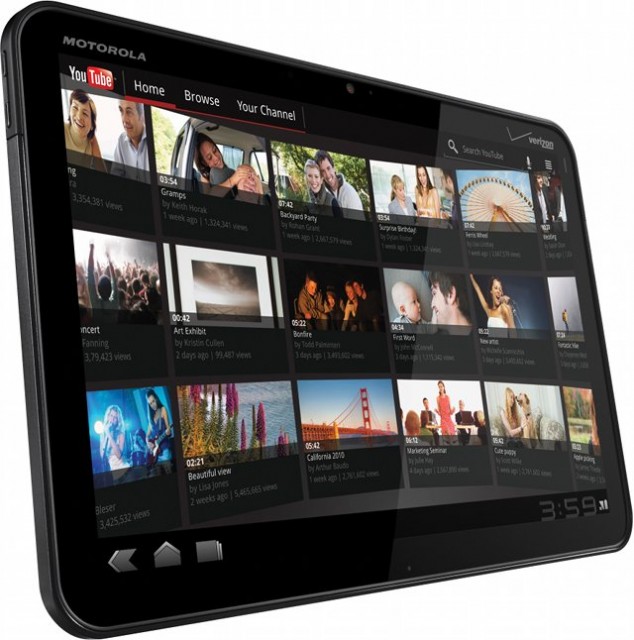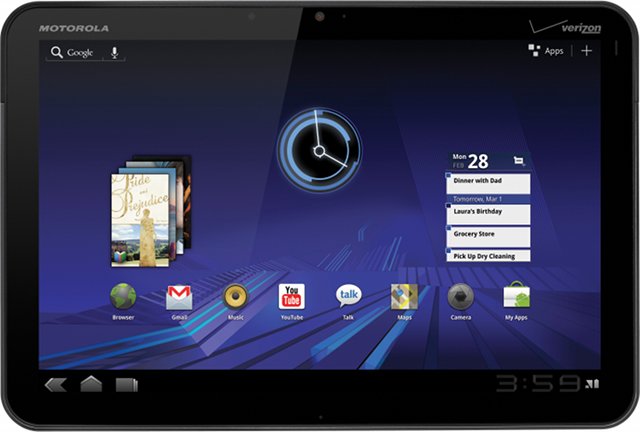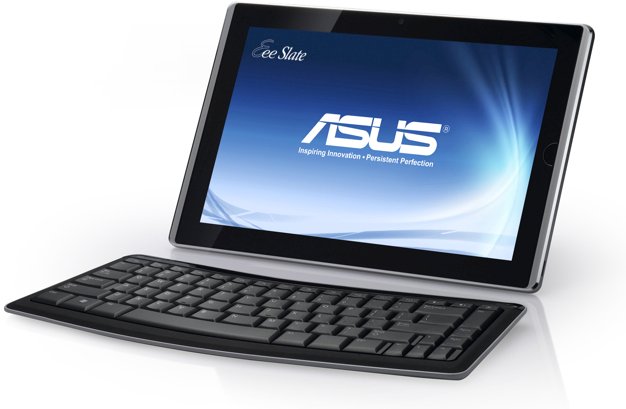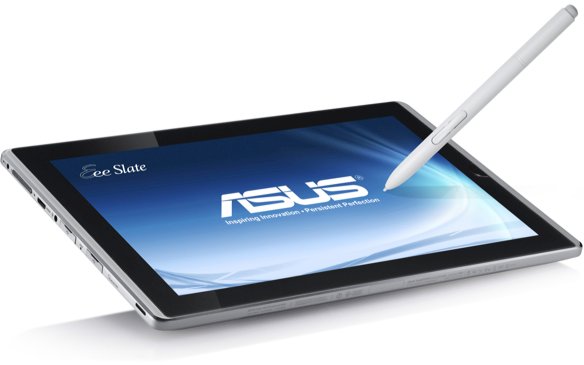
The iPad has a massive head start in software and a clear lead in design elegance, but in the tablet market, it’s no longer alone. As expected, this week’s Consumer Electronics Show brings a slew of tablets. Don’t call them iPad rip-offs, either. Given product development cycles, many of these products were likely in the pipeline before competitors saw the iPad. (There’s no doubt in the intervening time the iPad has made its mark, both as a benchmark of what to be and how rivals might differentiate themselves.)
Browsing, e-books, and games lead app consumption on iOS, but music software has nonetheless pushed the envelope of what these platforms can do. Music applications are often the most deep, sophisticated, and desktop-like (as in tools like Korg’s iMS-20 and Propellerhead’s ReBirth), and they’ve been some of the most adventurous in pushing the multi-touch interface (with countless unusual controllers and experimental interfaces). They’ve also made heavier use of hardware and network connectivity, with users regularly working with MIDI and audio hardware and wireless MIDI and OSC to connect to desktop computers.
So, what are the tablets to watch? And will these see the kind of heavy use by musicians and music developers the iPad has?
Honeycomb Android Tablets

The pitch: These devices are clearly iPad rivals, but with second-generation features (faster performance, cameras, higher-resolution screens). In turn, some or all of those same features are likely to crop up in a revised iPad some time in the spring.
Good example: The Motorola XOOM (see Android Tapp), due in the first quarter of the year here in the US with mobile connectivity from Verizon, is an indication of what’s to come. The videos are a bit dorky, from both Moto and Google, but the tablet itself looks quite nice. Motorola has also done a good job keeping up to date with OS updates on its Droid phone line. See also tablets from Asus and LG.
The hardware: Faster CPUs – while still far from desktop-class, dual core processors should boost audio processing capabilities. Faster GPUs – the NVIDIA Tegra is a serious GPU. Front- and rear-facing cameras. Higher-res screens, at resolutions around 1280×800. HD video. More hardware connectivity. (HDMI, USB, 30-pin ports, or some combination.)
The software: Android “Honeycomb” is what we’ve all been waiting for. Likely to carry version 3.0, this is the tablet-ready version of the OS.
How might music developers approach it? Initially, most won’t. Android is turning into a vibrant platform for general-purpose software development, but music developers face software that’s harder to develop than mainstream apps, yet with a potentially smaller audience and greater risk. And this whole field, iOS included, is very new. That means it’s more likely commercial music developers will focus efforts on iOS, even with new tablets. There’s a chicken-and-egg problem for music: early adopter users eager to consume music apps went for iOS, which brought developers there, which brought more users… There will be exceptions, and those few exceptions are likely to get lots of attention from Android users, carriers, and handset makers, but growth here will take more time.
Look instead for a vibrant open source community – not so much because Android is technically an open source platform, but because it’s easy to develop for and doesn’t require a Mac. Open source software should be a good fit, too, because it’ll allow a community of savvy users to crowd-source testing the wide array of Android phones and tablets out there. With phones alone, the payoff was limited, but with tablets, that could change. And that in turn could eventually lead to more commercial development.
How might musicians use it? The iPad has proven itself as a music platform, but I expect some musicians will snap up Android tablets, too. Faster processing speeds will give these platforms more robust sound-making capabilities, and at what looks to be competitive prices. Tablets in general work well as touch controllers for music apps and they’re great for reading (and soon, I suspect, editing) music notation. Free software like Pd, Processing, and OpenFrameworks will open up sophisticated sound and visuals. New capabilities in the browser could mean the web browser could turn into a tool for collaboration, a control surface, or a recording environment. And these machines could make nice, low-profile portable machines in place of a laptop, particularly if hardware connectivity is available. (See “lingering questions.”)
Versus an iPad: It’s all about the software. Android tablets should have competitive touch displays, performance, and hardware quality. But the Android OS can still be uneven for developers in terms of performance. And forget about “fragmentation” – more devices can be good; often the issue is odd device-specific bugs. On the other hand, Android could prove to be a more flexible platform, offer hardware choices that appeal to certain music applications, or provide better hardware connectivity. The simple truth right now is, we don’t know. But viva competition.
One simple difference: I expect Bluetooth MIDI will be very doable on the Android tablets. (There, at least that’s something that you can predict.)
Versus a Laptop: Tablet form factors and touch interfaces are more appealing for live performance and collaboration. They still lag in maturity and horsepower, however. Laptops have easy hardware connectivity, are far more capable of audio processing tasks, have more mature, tested designs, and generally deliver more bang-for-your-buck. That remains significant competition, and explains why commenters on this and other sites can be so skeptical of the tablet hype, even given the potential of the new designs.
Bogus claims: Android developers (Google and third parties alike) tout the “first” software to be developed “specifically for tablets.” It’s supposed to be a slam of the iPad as a giant iPhone, but these devices are still based on the Android platform. Worse, the consistency between iPad and iPhone interfaces is generally a good thing. The real issue is quality of design, one app at a time. That’s been especially true in music, as developers work – with varying degrees of success – to re-imagine these platforms as musical instruments. So I call marketing BS.
Lingering questions: The big questions all have to do with the new Honeycomb OS. While Android is open source, it’s anything but transparent – developers are usually the last to see new OS versions, and Google doesn’t say much in advance. As a result, we haven’t seen what Honeycomb will look like to developers. That leaves gaping questions, in particular, about hardware connectivity, and how developers may be able to make use of new ports for USB, HDMI, and the like. I’m also concerned that OS upgrades may be as spotty on the Android tablets as they have been on phones.
The other question: price. Will WiFi-only tablets be available, to rival the popular offering from Apple? Or will you only be able to get a $500 Android tablet after you sign a two-year data agreement with your mobile carrier, in turn limiting availability of the tablets in different countries? (Yuck!)
Windows Tablets (and Linux?)

The pitch: This one’s easier. These are basically PCs in tablet form factors. Want the horsepower and software of a laptop, but with multi-touch input and a slim, tablet case? This is for you. (See also the Indamixx tablets, one Atom-based, one Core-based – they take this model, too.)

Good example: Asus’ EP121 (see Engadget) has a Core i5, Wacom stylus, and Windows 7. It’ll cost around $1000, but then again, you get performance that rivals a laptop and you don’t have to sign a mobile contract – not a bad deal.
The hardware: Core-architecture Intel processors, more RAM, big SSDs. Some will have stylus input, in case you don’t like finger painting.
The software: Windows 7. Expect Linux alternatives to crop up quickly, too – and since this is essentially a PC, this is a better candidate for running Linux than the Android tablets.
How might music developers approach it? I have no idea whether Windows and Linux developers will take note of these machines, but if I were them, I’d consider one of these machines as my next laptop – especially as some will come with easy, detachable keyboards so you can actually code on them. On one hand, developers don’t actually have to do anything – because they run Windows (and probably Linux), existing desktop software will “just work.” On the other hand, desktop UIs can be kind of a mess with touch input.
Again, I think the open source development community might actually experiment first, even before commercial development becomes as viable as it has on iOS. If you use a tool like OpenFrameworks, you can simultaneously target this machine, an iPad, iPhone, and an Android device, all with native audio processing (using something like Pd, even), and OpenGL-accelerated graphics.
How might musicians use it? I’ll bet money we’ll see someone go out with Ableton Live on these machines. If it’s desktop software, it’ll run on these computers. The key is watching to see if Windows and/or Linux developers find ways to build touch-savvy apps. If commercial developers don’t, it’ll still make a killer machine for carrying around Pd or Processing or OpenFrameworks contraptions.
Versus an iPad: For a simplified, elegant, touch-centric design, there’s no contest. This is Windows running on tablet. On the other hand, this is a tablet that acts like a laptop, so for performance and desktop-class apps there’s no contest, either. And while Apple has some USB support via its Camera Connection Kit, it sure is nice to have normal USB ports here on the side. Real stylus input also isn’t available on the iPad, and having used the stylus doodads that are supposed to work on the iPad, I bet stylus lovers will choose this.
Versus a Laptop: Here’s where it gets interesting. Finally, people who like laptops won’t have to give up on touch input, especially as some of the new tablets will have keyboards. Of course, if you don’t care about tablets or touch, or you want a laptop that runs Mac OS, this isn’t terribly relevant. At least your choices aren’t as restricted.
Lingering Questions: There’s really only one big, ugly question: will anyone buy these? I think there are tons of reasons for musicians to prefer the laptop-style design with its extra horsepower and standard USB ports. The general market, though, is another matter.
Also, PC reliability has been all over the map, so as with any of these hardware offerings, we’ll have to get hands-on experience to know just how viable these machines are.
And Now, We Wait
Apple’s iPad remains the one safe bet you can go buy today, but in the coming weeks, that will change quickly. I think competition is healthy, not only for people who want alternatives to iOS, but for dedicated iOS users, too. And a big design challenge for software makers and (ahem) publishers will be making sure that the stuff we make works on these different platforms, so people with iPads and people with Android tablets can make some music together.
Stay tuned…